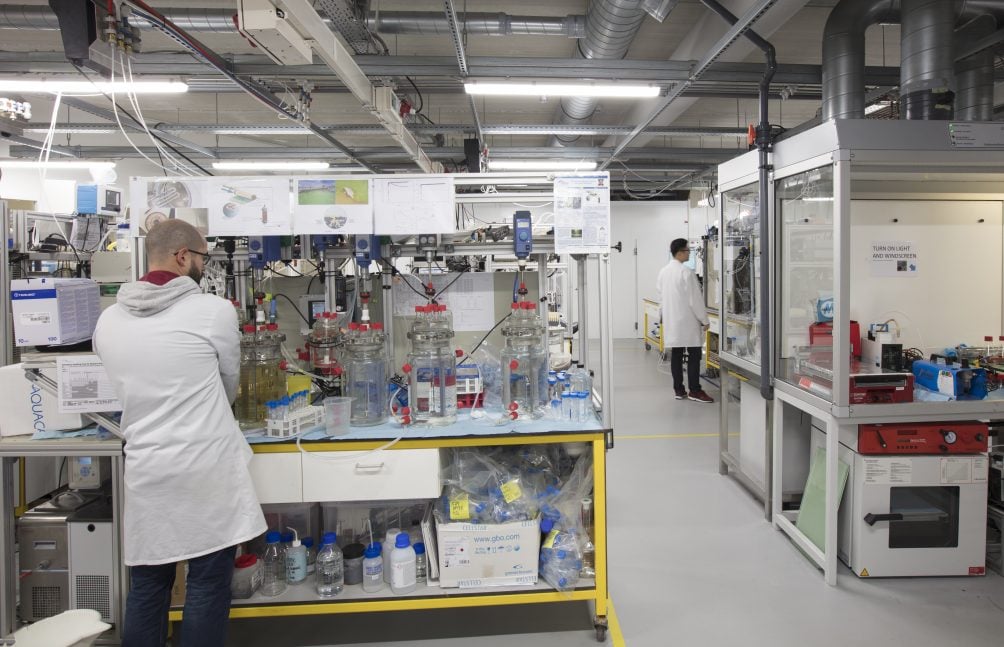NEW gets €8 million to roll out its water technology knowledge base
Published on by Water Network Research, Official research team of The Water Network in Non Profit
The NEW consortium will receive €8 million from the Dutch government to realize its water technology goals.

20-11-2017 Leeuwarden Wetsus Interieur Wetsus. Proefhal en laboratorium. ©Foto: Hoge Noorden/Jaap Schaaf
The Netherlands Enabling Water Technology (NEW), a Dutch consortium made up of Wetsus, the University of Groningen, Deltares and Investment and Development Company North Netherlands (NOM), is to receive €8 million from the Dutch government for the dessemination of knowledge on water technology. “This was a missing piece in the innovation chain,” says Jantienne van der Meij, Liaison Officer at Wetsus/WaterCampus Leeuwarden.
Van der Meij predicts that with the financial support from the NEW fund, more good ideas from start-ups will eventually make it to the market. “I jumped for joy when I heard it,” she says. NOM fund manager Rob Drees also sees the new investment as a high point. “We’ve been working towards this for such a very long time. There were more applications than were granted, so it remained exciting right up until the last moment.”
NEW helps start-ups in water technology who need to protect or validate their ideas. Or those who need entrepreneurial support and training, or are looking for funding. This focuses on e.g. water and resource recycling and in the field of generation and storage of energy harnessed from water. The NEW plan comprises two components: Knowledge transfer, and a fund.
It is precisely this combination that helps churn out successful start-ups. “It takes knowledge and expertise to develop a good idea into a successful water technology product or start-up,” says Van der Meij. “Developing an innovation into a product that is ready for the market also requires a financial investment. Guiding promising start-ups and connecting them to this fund will increase their chances of success.”

Jantienne van der Meij. Photo: Wetsus
Ten percent of the fund is sourced from private investors. This sends a positive message, according to van der Meij. “There is apparently a lot of interest from the investment world in innovative water technologies. I see that as auspicious. People understand that water is crucial in social challenges and that promising innovations deserve to be supported.”
Deltares and the University of Groningen (RUG) are also part of the consortium in addition to NOM and Wetsus. The RUG represents a wide range of scientific disciplines that are relevant to NEW. The university also runs the ‘Northern Knowledge’ valorization program, which is working on making insights from knowledge institutions in the north of the Netherlands accessible.
Start-ups as drivers for innovation
It is not always a given that a good idea will be funded, says Drees. “Especially in the early phase, when there is still a lot of uncertainty, it is difficult for a start-up to secure investments. That first phase is given a solid boost with the help of the Dutch government. We can offer start-ups better guidance this way.”
The fact that start-ups, in addition to existing SMEs, are given the opportunity to work on innovative technologies is also crucial, Van der Meij finds. “This early-phase funding was a missing link in the chain. We are facing major social challenges where climate change, circular economy and water quality are concerned. In fact, things have to be radically different. That’s why we have to keep on innovating and guiding new ideas to the market.”
A large number of start-ups are working on promising technologies even during this time. At the Water Campus, for example, Acquaint is working on a technology to inspect pipelines without actually having to dig up a pipe. “That’s a great example of how innovative a start-up like this can be,” says van der Meij. “This new investment will give us the opportunity to supervise more projects like this.”
Taxonomy
- Innovation
- Open Innovation Strategies
- Open Innovation